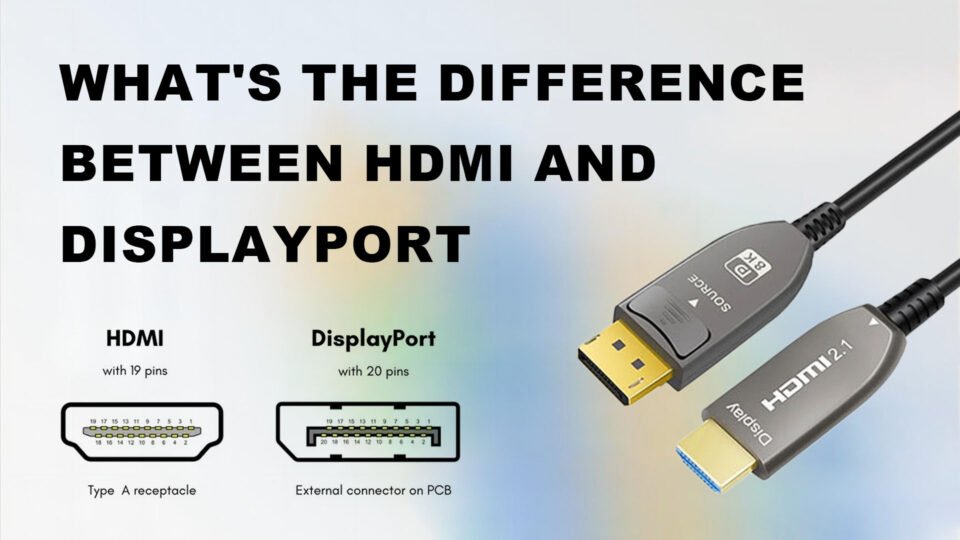- Introduction
- 1. Understanding HDMI and Fiber Optic Technology
- 2. Advantages of Fiber Optic HDMI Cables
- 3. Key Features and Benefits of 8K Fiber Optic HDMI Cables
- 4. Are Fiber Optic HDMI Cables the Best Choice?
- 5. Industry Applications and Consumer Trends
- 6. Conclusion
- Quick Links to 8K Fiber Optic HDMI Cables
- معلومات عنا
Introduction
In the ever-evolving world of technology, the demand for high-quality visual and audio experiences continues to rise. HDMI cables have long been the backbone of digital configurations. However, with the advent of كابلات HDMI الألياف البصرية, many are questioning their effectiveness and whether they surpass traditional copper HDMI cables. In this article, we’ll dissect the benefits and limitations of كابلات HDMI الألياف البصرية, including their 8K capabilities, and investigate whether they truly are superior.
1. Understanding HDMI and Fiber Optic Technology
1.1 What is HDMI?
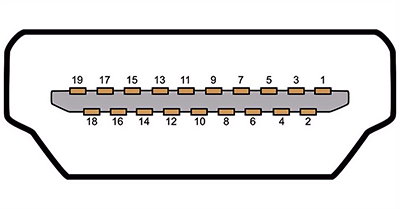
HDMI (High-Definition Multimedia Interface) is a widely used interface standard for transmitting high-definition audio and video data between devices. Here is a brief overview of its history and development:
History and Development of HDMI:
- Origins (2002): HDMI was first introduced in December 2002 by a consortium of seven companies: Hitachi, Panasonic, Philips, Silicon Image, Sony, Thomson, and Toshiba. The goal was to create a compact interface for transmitting high-definition video and audio signals, which could replace older analog interfaces like VGA and component video cables, as well as digital interfaces like DVI (Digital Visual Interface).At the time, HDMI was designed to provide a standardized and simplified connection that could support both video and audio data over a single cable. It was developed to support growing demand for HD content, with the emergence of devices like HD TVs, Blu-ray players, and video game consoles.
- HDMI 1.0 (2003): The first HDMI version, HDMI 1.0, was released in 2003. This version supported a maximum bandwidth of 4.95 Gbps, which was enough to transmit video at a resolution of 1080p at 60Hz, along with uncompressed 8-channel audio.
- HDMI 1.1 to 1.4 (2004–2009): Over the next few years, the HDMI standard continued to evolve, with HDMI 1.1 supporting DVD-Audio and HDMI 1.2 bringing support for One Bit Audio (SACD). In HDMI 1.3 (2006), the bandwidth increased to 10.2 Gbps, allowing support for higher resolutions, deep color (30-bit, 36-bit, and 48-bit), and Dolby TrueHD/DTS-HD audio formats.HDMI 1.4 (2009) introduced support for Ethernet over HDMI (allowing devices to share an internet connection), and more importantly, it added support for 4K resolutions (3840×2160) at 24Hz and 30Hz, as well as an audio return channel (ARC), enabling two-way audio communication between devices.
- HDMI 2.0 (2013): The منفذ HDMI 2.0 version, released in 2013, was a major update that increased bandwidth to 18 Gbps, which allowed support for 4K video at 60Hz. It also introduced support for up to 32 audio channels, 21:9 aspect ratio, dynamic auto lip-sync, and improved handling of 3D video.
- HDMI 2.1 (2017): Released in 2017, HDMI 2.1 is the current major standard. It introduced a significant increase in bandwidth to 48 Gbps, enabling support for 8K video at 60Hz و 4K at 120Hz, as well as dynamic HDR, which allows content to adjust its brightness and contrast on a frame-by-frame basis. Additionally, HDMI 2.1 supports features like Variable Refresh Rate (VRR) for smoother gaming, Enhanced Audio Return Channel (eARC), and Auto Low Latency Mode (ALLM).HDMI 2.1 also introduced support for 10K resolution, although this is more of a future-proofing feature, as few consumer devices currently support it.
- HDMI for Various Devices: HDMI has become the go-to standard for connecting devices such as TVs, computers, gaming consoles, projectors, and streaming devices. As the need for higher resolutions and faster refresh rates increases (especially with the rise of gaming and virtual reality), HDMI continues to evolve.
- HDMI in Modern Devices: Today, HDMI is present in most consumer electronics. Devices such as PlayStation 5, Xbox Series X, 8K TVs, and modern computers use HDMI 2.1 to take full advantage of high frame rates and enhanced audio and video capabilities.

Key Features of HDMI:
- High bandwidth: HDMI supports very high data transfer rates, making it ideal for high-definition and ultra-high-definition video.
- Audio and video in one cable: HDMI transmits both video and multi-channel audio over a single cable, simplifying the connection process.
- Support for advanced audio formats: HDMI supports advanced audio formats such as Dolby TrueHD and DTS-HD Master Audio.
- Consumer Electronics Control (CEC): Allows multiple HDMI-connected devices to be controlled by a single remote.
- HDCP (High-bandwidth Digital Content Protection): Provides content protection for transmitted video, ensuring that digital content remains protected from piracy.
Current Use and Future Trends:
As 8K content and beyond become more widespread, HDMI 2.1’s support for ultra-high bandwidth and dynamic features ensures it remains relevant. The addition of technologies like Variable Refresh Rate (VRR) و Enhanced Audio Return Channel (eARC) also makes it a prime choice for high-performance gaming and home theater setups.
High-Definition Multimedia Interface (HDMI) is the standard for transmitting high-quality video and audio between devices. Introduced in 2003, HDMI has undergone various updates, with HDMI 2.0 and HDMI 2.1 being the most prominent recent versions.
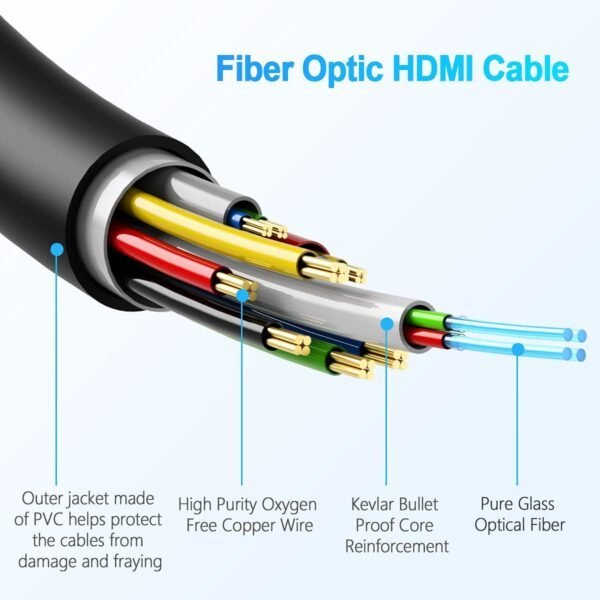
1.2 The Rise of Fiber Optic HDMI Cables
الألياف البصرية HDMI cables are a type of HDMI cable that use fiber optic technology to transmit audio and video signals. Unlike traditional copper HDMI cables, which transmit signals electrically, fiber optical HDMI cables use light to transfer data, enabling them to handle higher bandwidths and longer distances without signal degradation.
History of Fiber Optic HDMI
- Early Development (1960s-1980s): The foundational technology for fiber optics was developed in the 1960s, with early applications in telecommunications. The use of fiber optics for data transmission gained momentum in the 1980s, particularly for long-distance communication.
- Emergence of HDMI (2003): The HDMI (High-Definition Multimedia Interface) standard was introduced in 2003, allowing for the digital transmission of high-definition video and audio over a single cable. HDMI quickly became the industry standard for consumer electronics.
- Introduction of Fiber Optic HDMI (2000s): As the demand for higher bandwidth and longer transmission distances grew, manufacturers began to develop كابلات HDMI الألياف البصرية. These cables were designed to overcome the limitations of traditional copper HDMI cables, particularly for applications requiring 4K or 8K video, long-distance installations, and professional AV environments.
- Growing Adoption (2010s-Present): With the rise of 4K and 8K content, as well as advancements in home theater systems, كابلات HDMI الألياف البصرية have gained popularity among consumers and professionals alike. Their ability to maintain signal integrity over long distances has made them increasingly relevant in both home and commercial applications.
2. Advantages of Fiber Optic HDMI Cables
2.1 Signal Integrity and Ultra-Slim Design
One of the major advantages of using a fiber optic 8K HDMI cable is signal integrity. Fiber optics enable reliable data transmission over distances exceeding 100 feet, with no data loss or interference. The Super Slim 8K HDMI2 Fiber Active Optical Cable not only saves space with its ultra-slim design but also offers more flexible installation options.
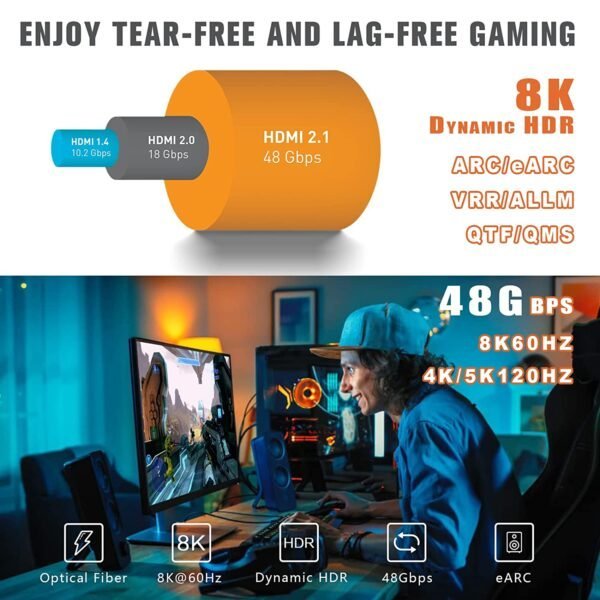
2.2 Enhanced Bandwidth for 8K Resolution
For those seeking the ultimate visual experience, such as gamers or home theater enthusiasts, the 8K HDMI fiber optic cable answers the call with superior bandwidth capabilities, supporting the latest resolutions and refresh rates found in 8K HDMI 2.1 fiber optic cable solutions.
2.3 Durability and Flexibility
Fiber optic cables are more durable and flexible than their copper counterparts. An active fiber optic HDMI cable is designed to withstand more wear and tear and can be routed easily in complex configurations. The design of the Super Slim 8K HDMI2 Fiber Active Optical Cable further enhances its durability and flexibility. and more.
3. Key Features and Benefits of 8K Fiber Optic HDMI Cables
3.1 Experiencing True 8K Resolution
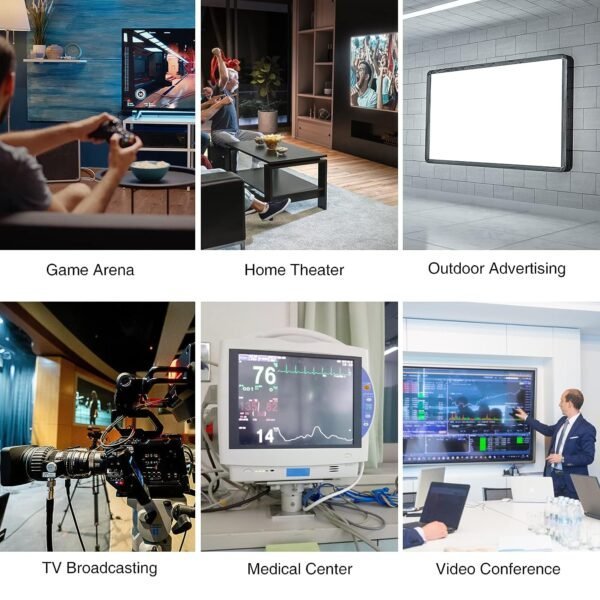
With technology advancing rapidly, more content is being produced in 8K. Using fiber optic 8K HDMI cables offers clarity that’s unparalleled, rendering images that are sharper and more detailed than ever before.
3.2 The Best 8K HDMI Fiber Optic Cable Options
When choosing the best 8K HDMI fiber optic cable, consumers should consider several factors: length of the cable, bandwidth capacity, and compatibility with their devices. Top models in the market, such as the Super Slim 8K HDMI2 Fiber Active Optical Cable, offer enhanced speeds, superior build quality, and extended warranties.
4. Are Fiber Optic HDMI Cables the Best Choice?
4.1 Comparing to Copper HDMI Cables
Copper HDMI cables have served us well, but their limitations, especially over long distances, make them less favorable compared to fiber optic options. An AOC fiber optic HDMI cable ensures consistent quality, free from the electromagnetic interference prevalent in copper cables.
4.2 Economic Considerations
While 8K fiber optic HDMI 2.1 cables generally come at a premium price, the investment is justified by their future-proof quality and performance that stands the test of time. The high cost-effectiveness of the Super Slim 8K HDMI2 Fiber Active Optical Cable makes it a worthy consideration.
5. Industry Applications and Consumer Trends
5.1 Applications in Professional Settings
In industries where the highest quality of video transmission is required, such as broadcasting or surveillance, fiber optic HDMI cables are becoming the standard.
5.2 Consumer Adoption and Satisfaction
Consumers who harness the power of these advanced cables often report a significant enhancement in their media consumption experience, reinforcing the perception that fiber optic HDMI cables, including the AOC fiber optic HDMI cable, are not just better but necessary.
6. Conclusion
In conclusion, كابلات HDMI الألياف البصرية offer an array of advantages that far surpass traditional HDMI cables, especially over 15m long distance transmissions. Their ability to maintain signal integrity over long distances, support for the most advanced resolutions, and overall durability make them a superior choice. With the ever-expanding media landscape moving towards higher resolutions such as 8K, the role of the fiber optic 8K HDMI cable in delivering the best video and audio experience cannot be overstated. Products like the Super Slim 8K HDMI2 Fiber Active Optical Cable further solidify the position of كابلات HDMI الألياف البصرية in the market with their exceptional performance and design.
Quick Links to 8K Fiber Optic HDMI Cables
-
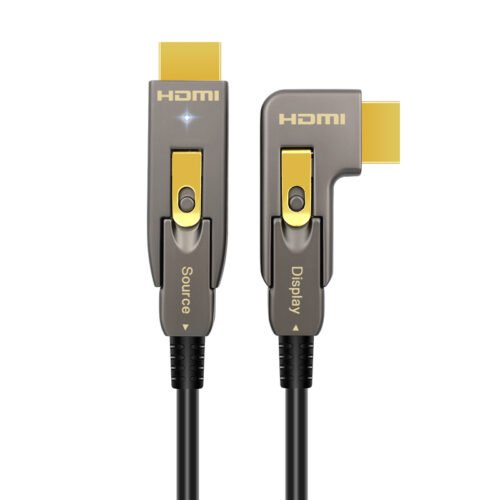 8K HDMI2.1 Fiber Optic Cable-Detachable-Latching-LED Indication,DM-Angled DM,48Gbps 4K/120Hz
8K HDMI2.1 Fiber Optic Cable-Detachable-Latching-LED Indication,DM-Angled DM,48Gbps 4K/120Hz -
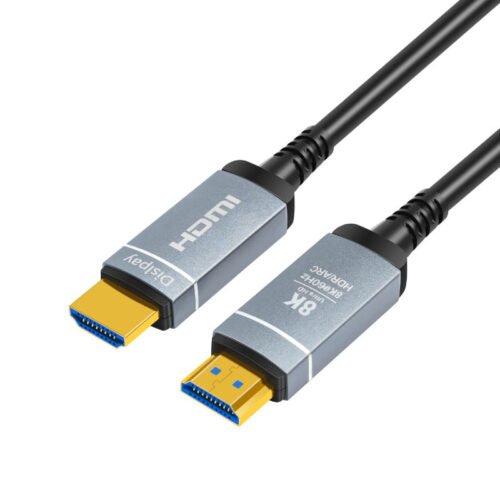 8K HDMI Fiber Optic Cable 100feet-HDMI 2.1-Aluminum Alloy Shell-8K/60Hz-48Gbps-Dynamic HDR 10 & eARC
8K HDMI Fiber Optic Cable 100feet-HDMI 2.1-Aluminum Alloy Shell-8K/60Hz-48Gbps-Dynamic HDR 10 & eARC -
 Super Slim 8K HDMI 2.1 Fiber Active Optical Cable-AM to AM-48Gbps
Super Slim 8K HDMI 2.1 Fiber Active Optical Cable-AM to AM-48Gbps -
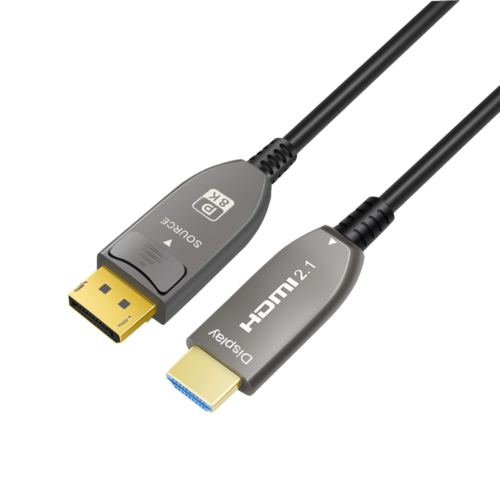 DisplayPort1.4 to HDMI Fiber Active Optical Cable-AOC-UHD 8K/60Hz,HDR,Black,20m
DisplayPort1.4 to HDMI Fiber Active Optical Cable-AOC-UHD 8K/60Hz,HDR,Black,20m -
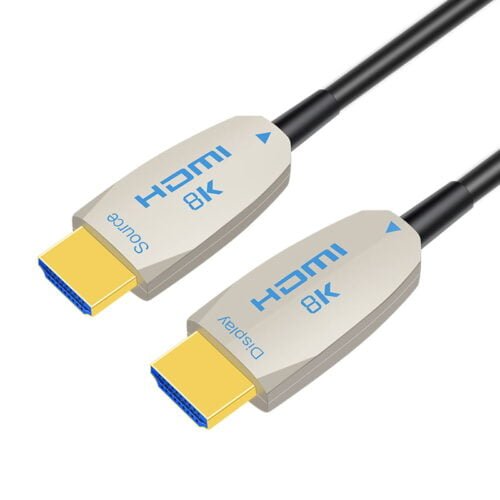 8K HDMI 2.1 AOC-Active Optical Cable-AM to AM-48Gbps
8K HDMI 2.1 AOC-Active Optical Cable-AM to AM-48Gbps -
 Detachable 8K Hybrid Active Optical HDMI Cable-Latching,DM-DM,48Gbps 8K@60Hz
Detachable 8K Hybrid Active Optical HDMI Cable-Latching,DM-DM,48Gbps 8K@60Hz -
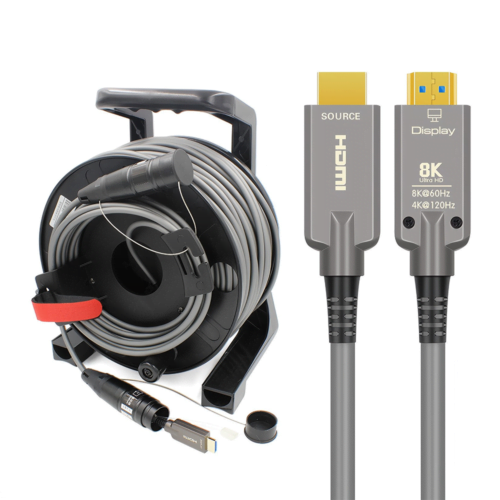 Armored 8K Fiber Optic HDMI 2.1 Active Optical Cable on Roxtone PCD 310 Drum
Armored 8K Fiber Optic HDMI 2.1 Active Optical Cable on Roxtone PCD 310 Drum -
 Four-In-One Armored 8K Fiber Optic HDMI2.1 Extension Cable on Roxtone drum
Four-In-One Armored 8K Fiber Optic HDMI2.1 Extension Cable on Roxtone drum -
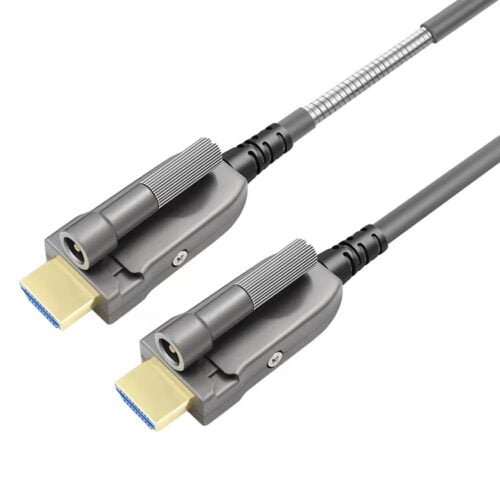 Fiber Optic HDMI 2.1 AOC-Active Optical Cable-Armored-8K@60Hz 48Gbps
Fiber Optic HDMI 2.1 AOC-Active Optical Cable-Armored-8K@60Hz 48Gbps
As the era of 8K content beckons, embracing the future of visual technology becomes inevitable. DJI’s Ronin 4D marks the beginning of a thrilling journey into the realm of ultra-high-definition visuals, and AOCFIBERLINK’s 8K UHD Active Optical HDMI Cables stand poised to deliver this breathtaking experience seamlessly into your home entertainment systems.
معلومات عنا
في فايبرلينك، نحن متخصصون في تصنيع منتجات عالية الجودة كابلات HDMI الألياف البصرية that cater to the demands of modern audiovisual systems. Our fiber optic HDMI cables are designed to deliver uncompromising performance, ensuring that you enjoy the true potential of your high-definition devices.
Besides the standard fiber optic HDMI Cables, we also provide tailor-made solutions for customer specific needs.
Please don’t hesitate to contact us.
You can also subscribe to our Youtube channel to stay tuned.




